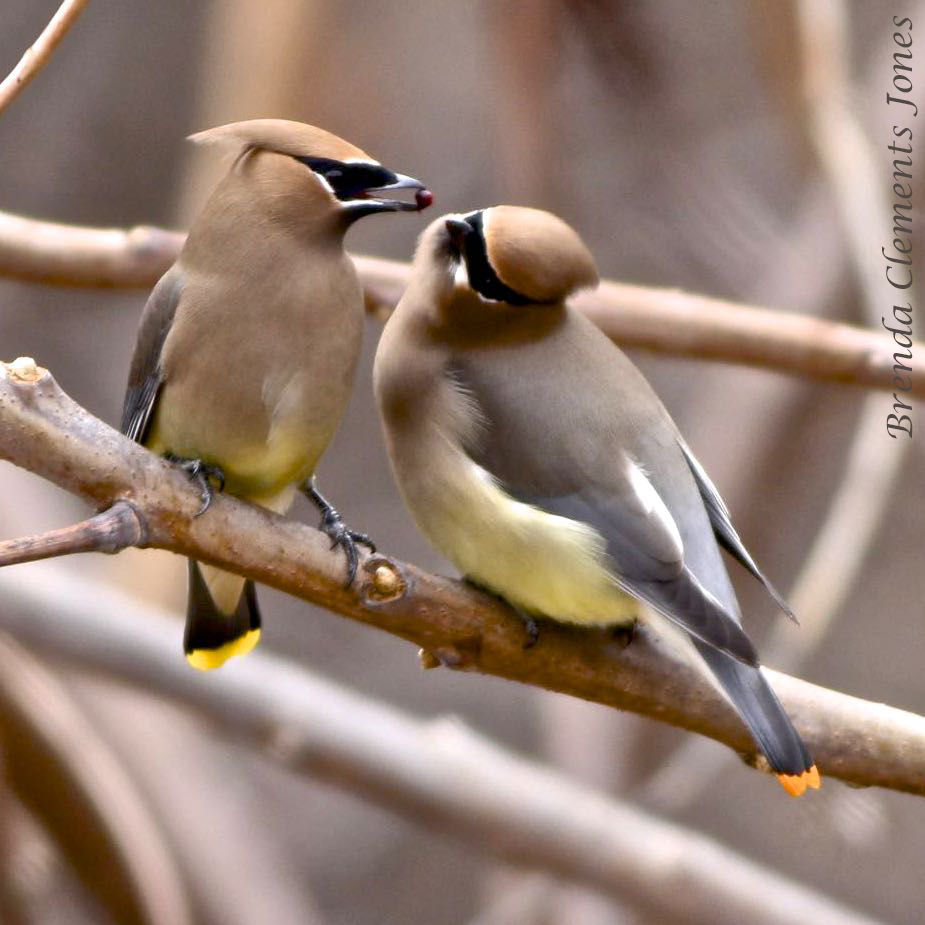
Perhaps you’ve seen this photo in the past. It’s one of my favorite images of the many many that I’ve taken. Surely I’ve used it before. These Cedar Waxwings (Bombycilla cedrorum) are performing a mating ritual in which the pair pass a treasure (in this case a sumac berry) back and forth. No telling which is the male and which is the female in this image since their markings and plumage are the same.

A pair of Cedar Waxwings are monogamous during each breeding season and both parents participate in nest construction and rearing activities. Incubation of the two to six eggs takes two weeks.

Born blind and helpless the nestlings grow quickly and learn to fly in another two weeks. The bird above is a juvenile who has yet to grow adult plumage. Juveniles do have the yellow tail tip, although not the red wing tips, yet.

The bird in the center of the photo above has an orange tail tip. That orange coloring is due to the diet of the bird. In the late 1800s the bush, Morrow’s Honeysuckle (Lonicera morrowii), was unfortunately brought to this continent. I say unfortunately because it is an invasive. The berries of this bush contain a red pigment. If enough of these berries are eaten by a Cedar Waxwing during feather formation the tail tips will be orange rather than the usual yellow because of that red pigment. This unusual coloring began to be noticed in northeastern U.S. and southeastern Canada in the 1960’s. Unusual but no other consequences as far as is known.

These elegant birds are irruptive and gypsies wandering from fruit supply to fruit supply throughout the year. They’ll also eat insects when they’re available. They love the sound of running water and enjoy small streams, or bird baths that have drippers or as in the case above, a puddle in the middle of a lane.

They travel in bands and normally when I see them they’re with their friends the American Robin. And in case you are trying to get your terminology just right, a group of Cedar Waxwings is called an “ear-full” or a “museum” of Cedar Waxwings.

Such a sophisticated fashion statement the Cedar Waxwing makes. And what of those red wing tips? They are a waxy secretion called astaxanthin – a carotenoid pigment. Don’t worry, there won’t be a test on this. As the years go by the number and size of the tips get larger. It is believed that these appendages are used as status symbols in mate selection.

I was surprised last spring to see several Cedar Waxwings eating petals off the apple blossoms in my tree. Now I know, they eat berries and fruit, insects AND flower petals. Who would have thought?

5 responses to “Cedar Waxwings”
Nature is so cool!! I take astaxanthin for its antioxidant properties. This carotenoid gives shrimp, salmon and crabs the red color and they are the main dietary source. Do you know if this also makes the red of cardinals?
Nancy
My Dearest Brenda,
In the short time I’ve been fortunate to receive your wonderful Tendrils notes/short essays, I’d like to say this one is amongst the best. Whether it’s the mentioning of seasonal monogamy, or food induced feather spectrometry you’ve passed a volume of information in a quite pleasant and always timing fashion. I will now say I will stop gushing over your skills and from now on leave smiles and kudo emoji type things.. but rest assured I feel happy knowing you[re out there doing what you love.
Hi Ken,
Thank you so very much for your kind comments. I thoroughly enjoy sharing nature with others and you can be sure that I am really doing what I love. On top of that I am learning so very much every single day. What more could I want. This particular post really was based on delight and fondness for an elegant and at the same time amusing species of bird, which enabled the words to just flow.
Thanks again for your kind words and thank you for reading my posts.
Bren
Hi Nancy,
You might know that I LOVE a mystery, and believe me, your question about Northern Cardinals and astaxanthin really got me “digging in the weeds” to solve the mystery. BUT I’ve found an answer. It does indeed play a part in the red coloring of cardinals. Check out pages 589 and 590 in the scientific paper: https://insider.si.edu/2014/05/feather-pigments/ and you will see that astaxanthin is part of the color of this beautiful bird!
Thanks bunches for presenting me with your question AND thanks for reading my posts.
Bren
nice find.